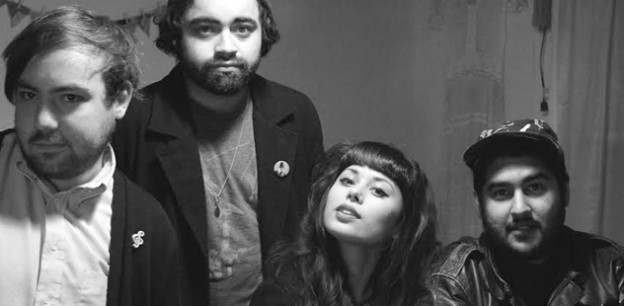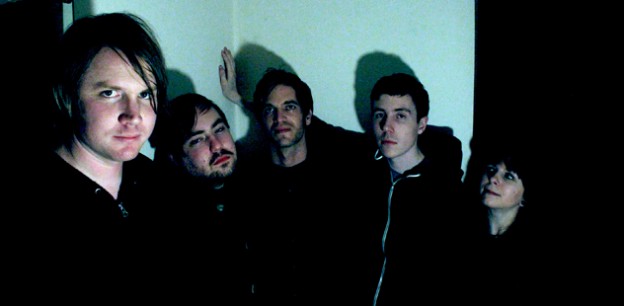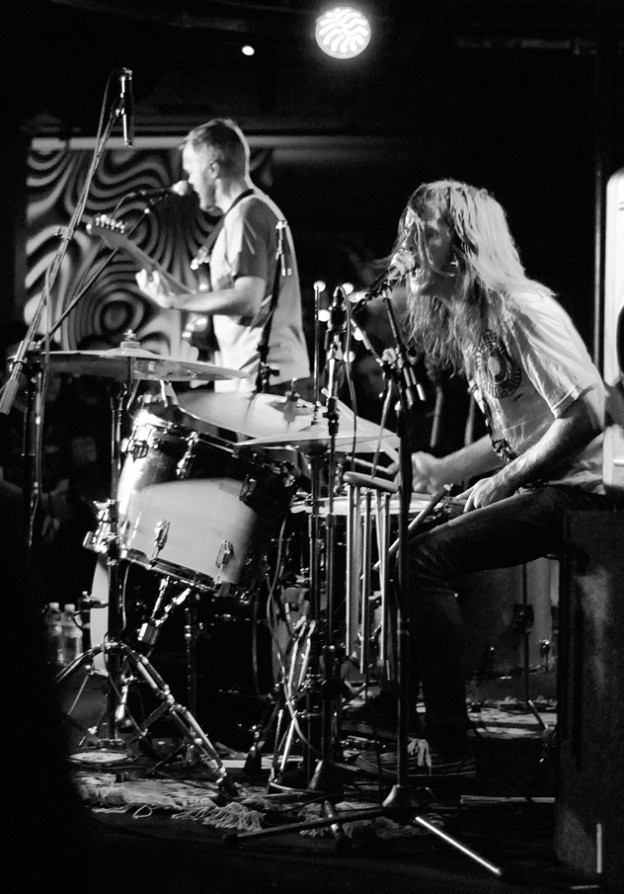Could G. Green Become Sacramento’s Most Loved Band?
G. Green was once the most unpopular band in Sacramento. Originally Andrew Henderson’s bedroom recordings moniker, his solo shows in Sacramento garnered anathema of clandestine ridicule and indifference. There was a time I loathed seeing the name listed on every Hub show and house party, and I wasn’t alone. It was fun to smear G. Green in 2009 and it was excruciating to see them on the verge of amateurish implosion in 2011. Most of you probably still assume G. Green is locked into a static identity as Midtown brats, drunk on youth, and too drunk to do much besides be obnoxiously loud. While we were laughing, when we stopped caring and stopped looking, G. Green quietly became a serviceable indie band, writing songs destined to shed the onus of snotnosed bush leaguers.
Before she became G. Green’s drummer, Liz Liles described the first G. Green show (a one-off lineup consisting of Henderson on guitar and promoter Rick Ele on drums) as horrible and a disservice to the former KDVS DJ’s sterling reputation.
“I thought ‘why is DJ Rick playing with this idiot,’” she said. “Me and whoever I was with, we watched one song and then went into the alley to smoke cigarettes.”
In the greenhorn years of the band, Henderson was the perpetual opener; the sort that would clear a venue, living room or DIY space except for his steadfast cheerleader, DJ Rick.
“I put him in front of audiences, and the awkwardness, the house slippers on his feet, and the most piercing moments of singing were initially a big turnoff to people,” Ele said. “But Andrew seemed totally impervious to disapproval.”
*****
They’re all laughing at you, aka the infamous Capital Bowl show
Mt. St. Mtn. founder and former Mayyors member Mark Kaiser put out G. Green’s first record, Crap Culture, in 2012, but it took time for him to become a backer. In gathering stories of infamous G. Green failures, Kaiser and Liles invoked the West Sacramento Capital Bowl show in 2008 without hesitation. In those days, bands would rent out the events room to play, and according to Kaiser, “trash.” The bill was geared toward trashing the place with Mayyors and Eat Skull (a notoriously self-destructive Portland band), while the G. Green solo set was the black sheep. Liles said she and her friends openly ridiculed the G. Green set. While Kaiser likened the clumsy solo performance as arriving “too late for that mid-’90s Olympia-wrought ‘any art is good art’ vibe.” Henderson was not going to be the next Calvin Johnson.
“Andrew was really young, and looked really drunk and really nervous,” Kaiser said. “He let loose, and I cringed. The show was fun, drunken chaos, all the bands on the bills were renowned for being a wasted mess, but this was excruciating.”
*****
Laughing: from ‘at’ to ‘with’
Liles might have mocked Henderson at first, but one evening he showed up at her Midtown home, then known as the Funcastle, expecting a Thee Oh Sees show. Liles had moved the show to another venue, but the encounter with Henderson sparked a quick friendship. At the time Liles was a—quote, unquote—drummer for experimental groups Sucks and Fatty Acid. Untrained and illiterate to tempo, she began telling Henderson she was G. Green’s new drummer.
Henderson obliged after booking a house show with Kurt Vile, Eat Skull and Ganglians. He had two months to put together an opening band; Liles was the first piece. The remaining guitar parts were filled out by Julian Elorduy (drummer for Mayyors in those days) and Dylan Craver. Two months proved enough and sustained the approval of scene-dad DJ Rick.
“I didn’t really know if the band would continue after that one show,” Henderson said. “Rick loved us and threw us on all these shows and put us on [Operation Restore Maximum Freedom]. Pretty much the reason Liz and I still play music together is because Rick threw us into the whirlwind of the Sacramento music scene at that time.”
Kaiser recalls being at the full lineup’s debut, despite purposely steering clear of solo sets since the bowling alley incident.
“The second time I saw Andrew play it was with this first incarnation of a live band and it was a world of difference,” he said. “It was sloppy and chaotic, but it was fun and there were lots of ‘whoa, if they keep doing that’ moments that had me intrigued.”
Henderson and Liles cherish the times with that early incarnation, but also knew it could never last. Elorduy quit the band after Liles broke up with him for Hella drummer Zach Hill, and was replaced by Brittney Gray on bass. Henderson and Craver were the best of friends and also prone to volatile feuds. Every show and practice was a fun, drunken gathering that flirted with implosion.
“We were so close as friends that none of it mattered if people liked us,” Henderson said. “We were just getting drunk and having fun. Me and Dylan were good friends and then we’d hate each other. He probably quit the band infinity times.”
Before the final nail was put in the original lineup, G. Green enlisted Andy Morin, long before his stint in Death Grips, to record their debut, Crap Culture. A shambolic and lo-fi collection of mad-dash punk songs, Crap Culture captured G. Green at the time—unruly and unpolished, but beneath the caterwaul existed nuggets of pop punk gold. Kaiser compared the record to Superchunk’s No Pocky For Kitty, lauding G. Green for maintaining their live energy on record.
“‘Pool Of Blood’ was the song that made me offer them a record,” he said. “That song was a sign they had something and were capable of growing past the kiddish fun-punk into something bigger.”
Crap Culture arrived late to the cultural trend of low-budget to no-budget albums, home-recorded on junkable equipment. It was recorded in 2010, but did not see release until August 2012. By then contemporaries like Wavves had ditched the intelligible scuzz for pop-punk polished for MTV. Also, by the release of Crap Culture on Mt. St. Mtn., G. Green featured a lineup far superior to the rag-tag group that winged it through the debut.
With replacements Simi Sohota on bass and Mike Morales on guitar, G. Green returned to the studio, paying Robby Moncrieff to record a follow-up at the Hangar. Besides being a friend of the band, Moncrieff was a popular choice having recorded Dirty Projector’s critically praised Bitte Orca and fellow Sacramento band Ganglians’ Still Living. Unfortunately Henderson said the band made the mistake of requesting Moncrieff “make it sound like Woodhouse,” meaning Chris Woodhouse, the Hangar engineer responsible for seminal linchpins like all eight Thee Oh Sees records and the A Frames.
Henderson said, “We didn’t use Robby as he should be used as an engineer. He did the best he could, but it’s not the way Robby works. There was no unifying theme with it. It was just a smathering of shit and it didn’t sound very good.”
The record was scrapped, except for two songs which became the “Funny Insurance” b/w “Sounds Famous” 7-inch. Liles corroborated their poor performance, attributing it less to Moncrieff, and more to the band for it sucking. They entered the studio with songs written by all the members with no vision for the band’s identity.
Liles said, “we’ve had really bad luck recording full records… until now.”

*****
New lineup, new lease…
On June 10, 2013 I drove my then girlfriend’s Altima to Davis to see Parquet Courts, a burgeoning Brooklyn band, and Fine Steps, a new project by Julian Elorduy. G. Green was also on the bill, so I planned to arrive late, still pegging G. Green as the perpetual opener. To my surprise Fine Steps was on when I arrived at the Davis Bike Collective. I caught their last two songs. I grew despondent realizing a full G. Green set stood in the path to Parquet Courts. Who agreed to this bat shit order of operation?
With no beer to drink and no cigarettes to smoke outside, I remained inside conceding that despite my efforts I’d been hoodwinked into a G. Green set. Now, I don’t recall particular songs from the set in that blazing, claustrophobic bike shop, but I do know that’s the night I stopped laughing at G. Green. The additions of Sohota and Morales gave them chops previously lacking in the dynamic. Liles had become a force, and Henderson’s once pubescent screech had caked enough nicotine on his vocal cords for a second lease on his balls dropping. There’s plenty to love about a band bent on belligerence, but when that same band backs it up with the skills to earn that abandon, they stop being local brats and graduate into a menace worthy of unleashing on the country at large.
This year on the porch of Kupros I confess to the founding members the Parquet Courts show is when I started believing in G. Green. Henderson states it was his birthday that night, while Liles mentions that Parquet Courts opened for them when they played Brooklyn’s storied 285 Kent venue. Both are unphased that I once detested their band. I was never the only one and I wasn’t the only convert either.
Liles said, “A lot of people probably haven’t been taking the time to see us lately because they saw us so many times three years ago and have decided there’s no way we’ve actually progressed.”
Henderson added, “There’s an image that probably still exists in a lot of people’s minds of these weird shitty kids that are drunk all the time and looking for the next party. We’re convincing people who’ve seen it from the beginning that we’re a great band now.”
Liles and Henderson turned 25 this year. Neither member wanted to be pigeonholed to perceptions developed when they were still teenagers. The upcoming Area Codes album was honed on tour, the band delegating a set it would play nightly until the songs were ingrained in their muscle memory. The decision to be professional and treat their live set with care translates to the album, which was recorded by Woodhouse, whose specialty is live tracking, room sound and mic placement. Even a late night of binging on spirits and karaoke at the Distillery couldn’t sandbag their comfort with the songs.
“We finally developed a sound that cut any bullshit,” Henderson said. “We didn’t really know how to make a band sound. In recording with Chris, he just documents what we’re doing.”
But is their scene-dad Rick Ele a proud papa?
“So many Chris Woodhouse productions have that unmistakable Woodhouse touch,” Ele said. “He becomes the fifth Beatle to so many bands, but in the case of Area Codes, I think he really just used his magic to maximize the G. Greenness of this record.”
Kaiser was equally impressed, keeping the band on his Mt. St. Mtn. roster for a second go-round, calling their current incarnation a “quick progression.”
“The new lineup came about and they tightened up both their live presence and song writing. I kept telling Andrew to just pony up the money and record with Woodhouse. He’s the wizard, he knows their sound and knows how to make them sound more like themselves. That’s what they did and this new recording is a huge step forward.”
The night at Kupros we drank enough short-n-talls of Coors Light and Jameson to carry the festivities to the former Funcastle, now also the home of Henderson. I apparently needed to try “tangler,” a moonshine-like infusion engineered by Liz’s boyfriend. Once there it was filmed and failed beer shotguns for the tour promo video, messy blueberry pancakes, and Guided By Voices’ Alien Lanes on the record player. As both made more of a mess than a mouthful in shotgunning the PBRs, I wondered how they ever got the stigma of a party band. Earlier that night Liles insisted they were misunderstood. “We’re not a party punk band, we’re a weird band,” she said. “The record only mentions pizza once!”
“We’re a straight up indie rock band now,” she said.
Most importantly are these last words from Ele, their cheerleader since day one. Watching a solo project from an awkward kid from Folsom become a band after making friends with the girl who laughed at his sets.
“Andrew’s always the heart and soul of the band as voice and chief songwriter, but through these lineup issues, Liz really stepped up to become the band’s leading co-star. They could change lineups 100 more times, and from now on, I’ll always think of Andrew and Liz as G. Green.”
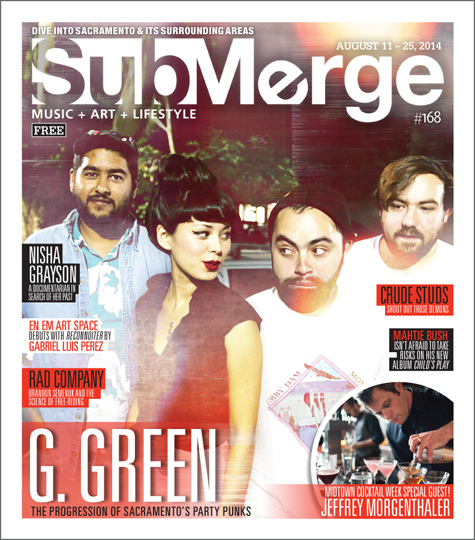
Celebrate the release of Area Codes Saturday, Aug. 30, 2014 at Witch Room (1815 19th St.) with G. Green, Rat Columns, Violent Change and more. The 18-and-over show starts at 8 p.m. and tickets are just $5. Check out
Facebook.com/ggreenband for more info.
Darling Chemicalia Releases Album Number Three, Spun in White
The word “evolution” implies not just adaptation to a changing environment, but also alludes to the increasing complexity of an organism. Local band Darling Chemicalia has been a fixture of the Sacramento live music scene for several years now, and they’ve reshaped, compounded in intricacy and proven their fitness to potential mates (you, the listener and showgoer) with the creation of their third record. Spun in White makes its official emergence in March.
Spun in White is the first Darling Chemicalia effort being put out by a record label— New York’s A Wicked Company. They recorded it themselves at their practice space, House of Hits, on Marconi. It showcases what the band is like live, and exhibits the new additions since Darling Chemicalia’s first two records, Valleys and Ghost Sketch, which were self-recorded by Ian Bone (vocals, guitar), Stephine Bone (vocals, keyboard) and Justin Gonzo (drums). Andrew Henderson (also in the totally rad band G. Green) lends a second guitar, and ex G. Green member Michael Feerick adds bass to the new record and evolution of Darling Chemicalia.
The 11 tracks that comprise Spun in White are each distinct from the last and catchier than a motherfucker upon repeated listens. The songs are spun together into an insidiously inviting web by common threads: youthful post-punk melodies; low-fi yet complex layered soundscapes; energizing pop influence; a dreamy underwater quality; Ian’s shaky, desperate vocals and Stephine’s raw, urgent, and longing vocals. Though they’ve preciously been compared to My Bloody Valentine and Sonic Youth, for me, Built to Spill qualities were immediately recognized when I first heard track one, “Final Girl.”
The album name comes from a Charles Bukowski poem, an excerpt of which reads:
“… And then the spider from his dank hole
nervous and exposed
the puff of body swelling
hanging there
not really quite knowing,
and then knowing—
something sending it down its string,
the wet web,
toward the weak shield of buzzing,
the pulsing;
a last desperate moving hair-leg
there against the glass
there alive in the sun,
spun in white;
and almost like love:
the closing over,
the first spider-sucking:
filling its sack
upon this thing that lived…”
As you can probably extrapolate from the tone of the poem above, the album is dark, and as Henderson described, “Claustrophobic—so much going on all the time in most of the songs… It’s what you’d feel like if you were in a crawl space and someone’s banging on the floor above you, but it’s good.” Henderson’s manner and voice reminded me of Mordecai from Regular Show.
It’s decidedly a loud, rocking record. Explains Ian Bone, “Growing up, I was super into Nirvana, and I never tried to do something like that. This doesn’t sound like Nirvana, but it’s as close as we can come to sounding like Nirvana. When you’re young, you get one record and obsess over it, immerse yourself in it. We don’t play a lot of shows where there are teenagers, and I want to know where the teenagers are. Because I wanted to make a record where some kid somewhere would listen to it and get obsessed. Actually listen to it all the way through.”
There’s so much going on musically in spite of managing to maintain minimalism, that it requires listening to it over and over again to really capture all of the things. Kind of like watching The Big Lebowski—no matter how many times I rewatch that movie, I catch some nuance in the dialogue that I’d never picked up on before, which makes it superior to a work that can be absorbed in one sitting.
“We’ve exhausted every melodic possibility for each song,” adds Ian, and while that’s mathematically improbable, the record is full of sound.
“Maybe we need to add a horn or something,” Henderson says jokingly.
“Yeah, that’s the next step,” concurs Ian sarcastically.
“We’ll make a ska record,” quips Gonzo.
Band dynamics will make or break even the most skilled group of musicians, and Darling Chemicalia is a tightknit alliance possessing pretty damn cute dynamics and dexterity to boot. In the beginning, it was just Gonzo, Ian and Stephine (the latter two had a baby three years ago). They added a guitarist momentarily but she didn’t work out.
One night in December 2012, when longtime homies Henderson and Feerick were going in on some booze with Gonzo and the Bones, Ian declared, “You should come join our band.” And so it was decided.
“It’s cool that we’re a band that is just friends anyway, and we’ve just become better friends,” Henderson elaborates. “We just like to play music together. We all look forward to band practice because we get to hang out with each other.” That camaraderie is palpable in the new record.
They rehearse once a week, randomly intersperse local shows, and on occasion venture out to San Francisco to perform. Their songwriting process varies. Ian brings ideas to the table half of the time, and as far as the other half goes, they’ll just be jamming at the beginning of practice and something worth exploring further arises. It took about a year to write the new record, and a year to record it—this was no haphazard process, but a painstaking and methodical one.
The album cover artwork for Spun in White is on par with the quality of the record itself. For the previous two albums, they utilized found photos, which are very cool images, but the new one was the first thing they actually did where it was a bit more premeditated.
“After we got married, Ian grabbed me and some residual wedding stuff…,” Stephanie Bone starts to explain.
“That sounds like a sexual thing, ‘it was our wedding night…’” teases Henderson.
“It wasn’t our wedding night, it was after we got married,” she clarifies.
The resulting picture is a beautiful, haunting image of a woman, spun in white, in itself a work of art.
Lofty future goals for the band? Define lofty…
“I’m still stoked every month that goes by that we’re all still doing this,” Ian says. “I don’t have any delusions of grandeur that we’ll be on the cover of the Rolling Stone or anything like that… if we can keep making something that’s good, as long as all of us are interested in doing it, then that’s good enough.”
“We’re finally going to go play in the Northwest, and that’s a huge step for this band,” adds Gonzo.
I disagree. Maybe they won’t get richer, or get their picture on the cover of the Rolling Stone, but I wouldn’t be surprised if this band is asked to play festivals like SXSW within the next couple of years, or is at least pleasantly surprised by a wealth of affirming, great reviews by notable music publications—not unlike this review.
Catch Darling Chemicalia at Witch Room’s first show on Tuesday, March 25 with Wax Idols, Wreck And Reference, So Stressed and Hollow Sunshine. Starts at 8 p.m., $8 cover, 18-and-over. Witch Room is located at 1815 19th Street (Bows and Arrows’ old space). For more information, visit Witchroomsac.com.
Two Gallants, G. Green
Harlow’s, Sacramento • Dec. 14, 2013
Sometimes I read over my recent reviews of shows or restaurants, and think, “Criminy! Am I just a crotchety old curmudgeon now who hates everything?” How refreshing it is to realize that this is not the case! While most things have a tinge of suck imbued into them, or just plain suck outright, there are good bands, good dishes, good men, good women and good days. I can love as much as I can hate.
The Two Gallants show, opened up by locals G. Green, on Dec. 14, 2013, and booked by Brian McKenna of Abstract Entertainment for Harlow’s Nightclub, had me feeling the love big time.
I know Two Gallants well, and they’ve known one another even longer, having written songs together since the age of 12. I was clamoring for the chance to review their set, but honestly knew little of G. Green. I assumed (again, because I have dickish tendencies and little time for pre-show research or repeat trips to catalog a band’s progress) that G. Green would be a coterie of whiny yet privileged hipsters with no real musical merit, albeit plenty of cool, contrived clothing. They were in their infancy when I saw their show years back at the now-defunct Javalounge, and they’ve since come a long way, baby.
For indeed, when G. Green took the stage at Harlow’s, right off the bat, I was doing that super nerdy head-bobbing dance and smiling like an idiot. These dudes are no joke, but rather a rad post-punk band hailing from Sacramento that showed me who was boss!
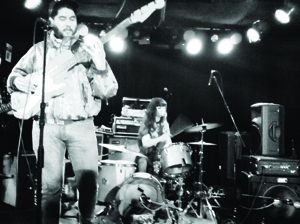
{G.Green, Photo by Niki Kangas}
These SXSW veterans’ most current LP is called Crap Culture, and they are working on an album as we (figuratively) speak with Chris Woodhouse.
Although each band member belts it out from time to time, frontman Andrew Henderson supplies minimalist lead vocals and guitar, while Mike Morales plays lead guitar and Simi Sohata provides a thumping, fuzzy garage bass undercurrent.
And then, there’s Liz Liles— an unparalleled babe with floor-grazing chestnut locks, porcelain skin, and strawberry red lips— drumming up legit, badass pounding tempos, and getting all the things in the room throbbing.
Maybe G. Green isn’t a wildly original concept, but they damn straight will get the room oscillating between bouncing and rocking.
And then came something elusive and magical that is so rare in the music industry: a perfunctory set change, which was followed by the headliners’ set taking off, like one of those whiplash-inducing zero-to-sixty-in-two-seconds rollercoaster rides. Or maybe it just seemed that way, following shots of tequila.
Have you ever had your heart metaphorically ripped out of your chest, thrown on a greasy, dirty floor right before your eyes, and stomped on until it was nothing but a smear of blood-spattered muscle dying in a sick, pulsating decrescendo? Two Gallants’ singer, Adam Stephens, perfectly conveys that experience with every agonized cry desperately flung from the pit of his stomach into the mic.

{Two Gallants, Photo by Melissa Welliver}
But this ain’t your tragic teenage nephew’s go-to screamo group. This two-piece band creates a wall of sound that is emotionally charged, anguished Americana, with roots in blues, folk, country and garage. Drummer Tyson Vogel lends backup vocals and beats out raw, traveling cadences that give legs to Stephens’ rolling, melodic fingerpicking and driving electric guitar soundscapes.
Hailing from foggy San Francisco, this duo borrows its name from the title of one of the short stories in James Joyce’s Dubliners, “Two Gallants.” They have released four full-length albums, and have toured the world over. Their most recent album, The Bloom and the Blight, was born after a five-year hiatus to a multitude of hungry fans.
This was not my first rodeo; after seeing Two Gallants kill their 45 minutes set another time, they did not at all disappoint. Stephens’ Stevie Wonder-esque sway holds a shadow of the joy characterized by the bespectacled Grammy-winning soul and pop artist— Stephens instead appears to be pained by every shaking utterance. Nonetheless, it is a happy catharsis to relate to him as he aches along with your deepest secrets, teamed up with a harmonic, danceable delivery. They’ll alternatingly melt your face off, and then bring it down a notch (or several) with their dirge-like storytelling hymns. Bipolar, sure, but at least you know you’re alive.
To sum it all up, they fucking rocked.
Chelsea Wolfe’s The Grime and the Glow dresses folk music in a black cloak
Ravens perched on bare branches, snow falling on tombstones, wooden shutters clattering against cloudy window panes in a strong gale–these are just some of the visuals The Grime and the Glow, the latest fulllength album from Sacramento songwriter Chelsea Wolfe, may conjure in the imagination of the listener. Songs such as “Cousins of the Antichrist,” on which Wolfe intones “All in vain” in a steady refrain as the song ends, reinforce descriptions of her music as dark or goth folk. Wolfe herself describes another selection from the album, “Halfsleeper,” as “a slow-motion painting of what it’s like to die in a car accident with your loved one.” Wolfe, however, admits that The Grime and the Glow isn’t necessarily all doom and gloom–not that she’d mind if it were. She says that songs “Advice & Vices” and “The Whys” are more playful lyrically than she’d normally write. Wolfe describes the latter as “a song making fun of myself for taking everything so seriously.” But these concessions aren’t in hopes of lightening the album’s dark mood.
“I don’t mind it getting too dire,” Wolfe says in a recent interview with Submerge.
From the album cover, to the videos made for the songs, to the music itself, The Grime and the Glow seems born from a single cohesive vision. Wolfe says that the theme for the album came to her once its title was in place. She says the title is taken from the introduction to the novel Death on the Installment Plan, by French author Louis-Ferdinand Celine. The darkly humorous novel had quite an effect on Wolfe, even though she wasn’t able to finish it.
“I…read most of [it], but had to stop because of the dark place it puts my head space,” she explains. “I didn’t really need to dig any deeper into understanding that much of the beauty in the world is crawling with worms beneath the surface.”
To get the dark and distant sound that permeates the album, Wolfe took a much more stripped down approach compared to that of her previous release, Soundtrack VHS/Gold. For that album, Wolfe says she went into a nice studio in order to create a “tapenoise- sounding” album, but she “eventually realized how illogical that was.”
“It’s a very different album,” Wolfe says of her previous effort. “I wanted to get an eight-track sounding record in a nice studio. Didn’t make any sense, but we did mix it down to tape.”
Wolfe says she wasn’t unhappy with the results, but instead with the lengthy recording process leading up to the release of Soundtrack VHS/Gold, which was released in an extremely limited run of about 50 CDs on Chicago-based indie label Jeune Été Records.
This time, Wolfe took a more “logical” approach to making an eight-track sounding album by using an actual eight-track machine. The Grime and the Glow was recorded by Wolfe on a Tascam 488, a handme- down from her musician father, that she says she’s recorded on for years. Wolfe says that doing the album herself, on a familiar machine, “made it sound exactly the strange and special fucked up way I wanted it to sound.”
Strange and fucked up are excellent adjectives for The Grime and the Glow. Though the mood is consistently dark, songs range from the wildly dissonant “Deep Talks,” which grates Wolfe’s bittersweet voice through layers of noise, to the aforementioned “Advice & Vices,” a catchy piece of dark pop that’s as tuneful as it is morose–and she sure doesn’t skimp on the reverb.
“I also like clean, straightforward vocals sometimes and will experiment with that someday,” Wolfe says, “But for these songs I wanted to capture my voice or the instruments, whatever, inside a certain soundbox, so when you have your headphones on listening to it you feel like you’re in a tiny, claustrophobic echoroom or a parking garage cathedral.”
Adding to the eerie, almost antique sound of the songs is the album’s format. The Grime and the Glow will be released some time in June–pushed back from the original May 18 release date–on limited edition vinyl by New York-based label Pendu Sound. Wolfe says that it was the label’s decision to release the album on vinyl, but it’s a decision she’s happy with.
“I don’t think this album would work as solely a CD release,” Wolfe says.
In addition to the music, Wolfe has also been busy working on visual companions to the songs. The Pendu Sound Web site for The Grime and the Glow features a series of four videos created for “Advice & Vices,” “Moses,” “The Whys” (featuring camera work by local horror filmmaker Jason Rudy) and “Bounce House Demons.” The videos for “Moses” and “Bounce House Demons” star Wolfe’s friend, writer Jessalyn Wakefield, whom Wolfe calls, “a perfect visual muse.” At the time of our interview, Wolfe also mentioned that she was working on a video for the song “Widow,” which will feature a “goth-glam girl lip-synching the song in a dark studio.”
“I like the element of darkness mixed with a bit of silliness,” she says.
This mix of music and film comes as no surprise as Wolfe states that movies had a big influence on her in the making of The Grime and the Glow.
“The Seventh Seal is my long-time favorite film,” says Wolfe, who also listed David Lynch’s Eraserhead and Jean Rollin’s French vampire movies as sources for inspiration. “The character of death in that film has forever been an influence in my creative life. Ingmar Bergman in general is a big inspiration for me. The portrayal of life in his films is so honest and desolate but rich at the same time. Another favorite is The American Astronaut (Cory McAbee), a dark space-western with hand-painted special effects and a pretty low budget that manages to get such a defined feel across, haunting but still silly, like so much of the folk art I love.”
In fact, Wolfe finds inspiration from most forms of art–but not so much with other music.
“Throughout my life and for this album I’ve been very inspired by authors, poets, painters and filmmakers, more so I’d say than any band or musician,” she explains. “In fact, for many years I wouldn’t allow myself to listen to music because I didn’t want to infuse anyone else’s sound into my own–I wanted to see what would happen without that influence.”
The Grime and the Glow is a solo project, but it was still a collaborative effort. Andrew Henderson of G.Green, Ian Bone from Darling Chemicalia and Ruven Reveles all made appearances on the album. Kevin Dockter, Drew Walker and Addison Quarles (collectively known as The Death) and Ben C. also played parts and have come together to form Wolfe’s band. Wolfe, Dockter, Walker, Quarles and C. will be heading into a proper studio in June to record a fivesong EP. Wolfe says her past experience working on Soundtrack VHS/Gold will inform her decisions on her upcoming trip to the studio.
“I’m much more focused, and I’m also giving this recording a deadline,” she says. “I’m going to try and finish up five songs in about a week and a half, which will mean lots of late nights and hard focus. This project will also be with my band mates–all five of the songs will have the same five people on them, which is a first for me. But I’m very excited about the challenge of finishing something on a fixed time limit.”
Until then, The Grime and the Glow should sate those with appetites for dark music, as long as they don’t mind the worms.
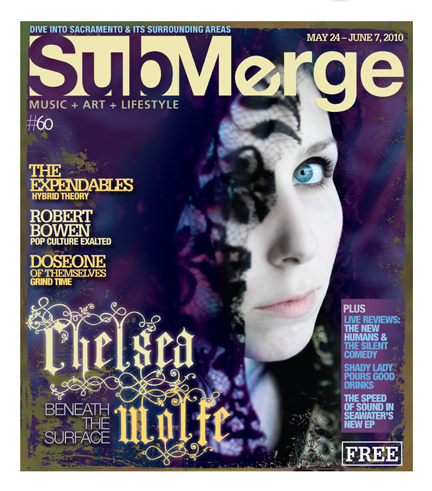
The Grime and the Glow is available for preorder through the Pendu Sound Web site. Go to pendusound.com/releases/psr-0040/. Those who pre-order the album will receive four free bonus songs for download.

